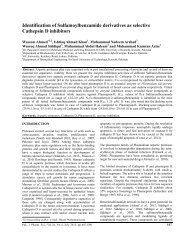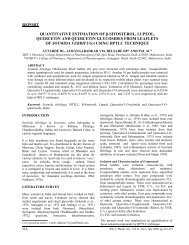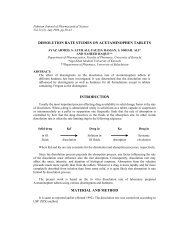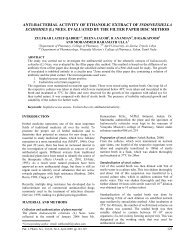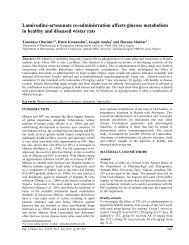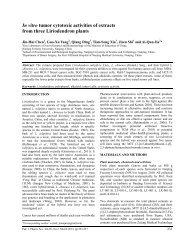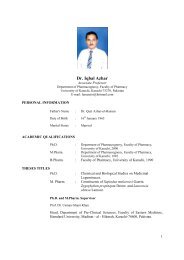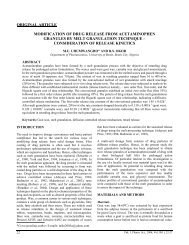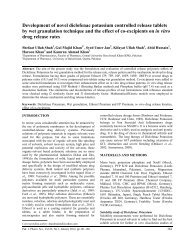EFFECT OF STARCH 1500 AS A BINDER AND DISINTEGRANT IN ...
EFFECT OF STARCH 1500 AS A BINDER AND DISINTEGRANT IN ...
EFFECT OF STARCH 1500 AS A BINDER AND DISINTEGRANT IN ...
Create successful ePaper yourself
Turn your PDF publications into a flip-book with our unique Google optimized e-Paper software.
<strong>EFFECT</strong> <strong>OF</strong> <strong>STARCH</strong> <strong>1500</strong> <strong>AS</strong> A <strong>B<strong>IN</strong>DER</strong> <strong>AND</strong> <strong>DIS<strong>IN</strong>TEGRANT</strong><br />
<strong>IN</strong> LAMIVUD<strong>IN</strong>E TABLETS PREPARED BY HIGH SHEAR WET GRANULATION<br />
BYTUL M. RAHMAN, MIR IMAM IBNE WAHED, PROMA KHONDKAR, MARUF AHMED,<br />
ROBIUL ISLAM, RANJAN K BARMAN* <strong>AND</strong> M. ANWAR UL ISLAM<br />
Department of Pharmacy, University of Rajshahi, Rajshahi-6205, Bangladesh<br />
*Quality Compliances Department, Square Pharmaceuticals Ltd. Bangladesh<br />
ABSTRACT<br />
High shear wet granulation is a preferred manufacturing method of tablets. It allowed for rapid production of<br />
compressible granulations. The resultant granulation characteristics depend on a combination of formulation<br />
properties and processing parameters. Fully pregelatinized starches are currently being used as binders in wet<br />
granulated formulations. But due to the gelatinization, much of the disintegration properties are lost. Partially<br />
pregelatinized starches (Starch <strong>1500</strong>) have a mixture of properties of both native and fully gelatinized starches;<br />
made them useful as both a binder and a disintegrant in wet granulated formulations. Starch <strong>1500</strong> performed as<br />
an excellent binder producing a granulation that was compressible and produced Lamivudine tablets of<br />
improved hardness and friability compared with those prepared with povidone. The formulation of Lamivudine<br />
tablets with Starch <strong>1500</strong> exceeded the disintegration and dissolution performance of the povidone formulation<br />
that utilized a super disintegrant. High shear wet granulation is also well suited for the use of partially<br />
pregelatinized starches.<br />
Keywords: Starch <strong>1500</strong>, binder, disintegrant, lamivudine tablets, wet granulation.<br />
<strong>IN</strong>TRODUCTION<br />
The majority of formulations in the development of new<br />
drug products contained maize starch that was used as a<br />
both binder and disintegrant (Herbert et al., 1989). But<br />
now present days, its use was limited because the starch<br />
lost much of its disintegration properties when it<br />
gelatinized in the preparation of the starch paste<br />
(Colorcon, 2005). As a dry addition to the granulation, the<br />
maize starch did not flow well and was not very<br />
compressible.<br />
Today, polymers such as povidone are preferred as<br />
binders for wet granulated products. When hydrated these<br />
binders produce viscous, tacky solutions. The tackiness<br />
holds the individual granules together. Added dry to a<br />
granulation polymers aid in the agglomeration of fine<br />
powders upon addition of an appropriate solvent to the<br />
granulator. However, polymer binders can also lead to<br />
processing difficulties such as rapid over granulation.<br />
Over time they occasionally lead to tablet hardening and a<br />
decrease in dissolution performance (Colorcon, 2005;<br />
Moore and Flanner, 1996).<br />
A balance must be maintained between the binding and<br />
the disintegration properties of a formulation. When<br />
polymer binders are chosen, the addition of strong<br />
disintegtants such as super disintegrants is typically<br />
required but these are considerably expensive and have a<br />
negative effect on product stability as well as film coating<br />
appearance of the finished products (Levina and<br />
Cunningham, 2005). An alternative to maize starch and<br />
polymers for wet granulations is pregelatinized starch that<br />
is a starch that has been previously gelatinized and dried<br />
to powder form (Cunningham et al., 1999; Anastasiades<br />
et al., 2002).<br />
Lamivudine (2’,3’-dideoxy-3’-thiacytidine, commonly<br />
called 3TC) is a potent oral nucleoside analog reverse<br />
transcriptase inhibitor (nRTI) has demonstrated efficacy<br />
against the hepatitis B virus (HBV) in both HBeAgpositive<br />
and HBeAg-negative patients with chronic<br />
hepatitis B. Treatment with lamivudine is safe and well<br />
tolerated and induces a virological and biochemical<br />
response in most patients within a short time. In 1998,<br />
lamivudine became the first commercially available oral<br />
agent for the treatment of chronic hepatitis B. Lamivudine<br />
is a synthetic nucleoside analogue that undergoes<br />
intracellular phosphorylation to its active metabolite,<br />
lamivudine triphosphate. Unlike interferon, lamivudine<br />
has direct antiviral activity and is a powerful inhibitor of<br />
HBV reverse transcriptase (Doong et al., 1991).<br />
Lamivudine has been used for treatment of chronic<br />
hepatitis B at a lower dose than for treatment of HIV.<br />
Long term use of lamivudine unfortunately leads to<br />
emergence of a resistant hepatitis B virus (YMDD)<br />
mutant. Despite this, lamivudine is still used widely as it<br />
is well tolerated.<br />
Wet granulation is a commonly used method used in the<br />
manufacture of tablets, which improves the tabletting<br />
process via the production of a product (granulate) that has<br />
Corresponding author: Tel: +88(0721) 750041/4110, Fax: (+880721) 750064, e-mail: bmokaddes3@yahoo.com<br />
Pak. J. Pharm. Sci., Vol.21, No.4, October 2008, pp.455-459 455
Effect of starch <strong>1500</strong> as a binder and disintegrant in lamivudine tablets<br />
improved flowability, uniformity and compressibility when<br />
compared to original drug containing powder blend. There<br />
are many methods used in the pharmaceutical industry to<br />
produce granules however the most common is high<br />
shear. As with most pharmaceutical processes wet<br />
granulation is a complex one, in which many factors such as<br />
binder used and processing conditions will influence the<br />
physical properties of the resultant granule. The object of<br />
this exercise is to develop an optimum granule in terms of<br />
compression properties and flowability in the short time<br />
available without considering the numerous variables in<br />
great detail. The approach is to screen a number of<br />
disintegrants and binders on the small scale and assess the<br />
product for physical and chemical characteristics.<br />
This study compared the high shear wet granulation and<br />
tablet properties of two formulations of Lamivudine. One<br />
is based on a polymer, povidone in combination with a<br />
super disintegrant, sodium starch glycolate. Another<br />
formulation utilized partially pregelatinized maize starch<br />
as both the binder and the disintegrant.<br />
MATERIALS <strong>AND</strong> METHODS<br />
Materials<br />
Table 1 listed the formulations evaluated for this study.<br />
Lamivudine USP (Hetero Drugs Ltd. India) was kind gift<br />
from Square Pharmaceuticals Ltd. Bangladesh. The<br />
excipients were present in the tablets: microcrystalline<br />
cellulose or Avicel pH 102 (Angel Associate, Taiwan),<br />
povidone BP (Kollidon 30; B<strong>AS</strong>F), pregelatinized starch<br />
(Starch <strong>1500</strong>; Colorcon), sodium starch glycolate (Yung<br />
Zip Chemical Ltd. Taiwan) and magnesium stearate<br />
(Peter Greven, c.v. Netherlands).<br />
Methods<br />
The granulation process was carried out in TK Fielder<br />
PMAT-10 (Niro Inc). The batch size was 2.5 kg for each<br />
trial. Materials were preblended for 5 minutes prior to<br />
granulating with an impeller of 250 rpm and chopper<br />
speed setting of II. Drying was done using fluid bed drier<br />
with an inlet of 60 o C. Each batch was dried to moisture<br />
content about 2% w/w which was close to the preblend<br />
LOD measured earlier.<br />
Final sizing of the granulations was performed by hand,<br />
using a 20-mesh screen. Granules were manufactured and<br />
physically characterized by measuring, particle size<br />
distribution, angle of repose (Banker and Anderson, 1986),<br />
and bulk and tapped density (Phadke and Anderson, 1990).<br />
Hausner factor, the ratio of tapped density to poured<br />
density, was also studied and calculated for the tested<br />
granules as evaluation parameters for compressibility.<br />
Particle size distribution of the granules was determined by<br />
sieve analysis using 30 g of the granules. Series of US<br />
standard sieves ranging in screen opening from 315 to 800<br />
456<br />
µm were used. The granules were placed on the top sieve<br />
and were mechanically shaken for 10 minutes on a shaker<br />
(Rota C30, Germany). The fraction retained on the sieve<br />
weighted and average particle size was calculated (Railkar<br />
and Schwartz, 2001).<br />
Lubricants were passed through a 60-mesh screen prior to<br />
blending. Blending was performed with a tumbling mixer<br />
(Patterson-kelly Twin shell blender. Model LB 331). All<br />
ingredients except lubricant were blended for 10 minutes.<br />
The efficiency of mixing was verified by determination of<br />
drug content. The lubricant was added and blended for an<br />
additional 5 minutes.<br />
The produced mixture was compressed into tablets using<br />
an instrumented 35-station BB4 tablet compression<br />
machine (Manesty, England), fitted with 8mm deep<br />
concave tooling; at 23 rpm. The machine was adjusted to<br />
produce tablets of 200 mg in weight and each contains<br />
150 mg of Lamivudine. For each formulation a<br />
compression profile was generated covering 4 to 20 kN.<br />
The tablet properties were evaluated after compression<br />
with an Erweka Multicheck using a sample size of 10<br />
tablets. Tablet thickness was done according to USP 30.<br />
The experiments were done 6 times and the mean value<br />
and standard deviation were calculated. Friability was<br />
evaluated at 100 drops using an Erweka Friabulator.<br />
Disintegration times were measured according to USP 30<br />
with an Erweka DT bath using deionized water.<br />
Dissolution testing was performed in a USP compliant<br />
dissolution bath using apparatus 2 (paddle method) at<br />
50rpm. The apparatus (Erweka) was assembled and one<br />
tablet containing 150 mg of Lamivudine was placed in<br />
900 ml of purified water which was warmed to 37 ± 0.5°C<br />
previously. After 15 minutes, 10 ml of sample was<br />
withdrawn from dissolution medium using glass pipette<br />
and filtered with filter paper and replaced immediately<br />
with same volume of fresh medium maintained at the<br />
same temperature. The withdrawn solution was diluted<br />
suitably to achieve the drug concentration 1.66mg/100ml<br />
and the amounts of Lamivudine released were determined<br />
spectrophotometrically at 272 nm using dissolution<br />
medium as a blank. All assays were done in triplicates<br />
and the mean values were calculated. This testing was<br />
repeated on 30 and 45 minutes.<br />
RESULTS <strong>AND</strong> DISCUSSION<br />
The prepared granules, using wet granulation method,<br />
were evaluated prior to compression into tablets (table 2).<br />
The granules with (Formula 2) and without (Formula 1)<br />
Starch <strong>1500</strong> showed similar values of for the angle of<br />
repose which indicate good flowability. This is also<br />
supported by the data of Hausner factor which indicate<br />
good flowability for the granules.<br />
Pak. J. Pharm. Sci., Vol.21, No.4, October 2008, pp.455-459
Table 1: Composition of the prepared Lamivudine USP 150 mg tablet formulations.<br />
Formula 1 was listed in table 1 and utilized common<br />
granulation excipients. The quantity of each ingredient<br />
was chosen to be within the recommended use levels. The<br />
granulation contains microcrystalline cellulose (MCC) at<br />
approximately 10% internally and 4% externally to the<br />
granulation. MCC lost some compactability when used in<br />
wet granulations; therefore, it was desirable to incorporate<br />
a portion of it externally to ensure good tablet hardness.<br />
The dissolution performance of the granulated<br />
formulation was improved using super disintegrant both<br />
internally and externally to the granulation. Sodium starch<br />
glycolate was used at 5% of the formulation and was split<br />
equally between the phases.<br />
Formula 2 was listed in table 1 which was developed<br />
using Starch <strong>1500</strong> as binder and disintegrant. All<br />
povidone, sodium starch glycolate and internal MCC were<br />
replaced with Starch <strong>1500</strong>. It was an effective disintegrant<br />
but not super disintegrant and typically needs to be used<br />
at higher levels to gain similar disintegration<br />
performance. The level in the external phase was 6%.<br />
Fig. 1 displayed the tablet hardness of the two<br />
formulations. Both produced tablets have comparatively<br />
acceptable hardness in the compression force 6 kN but<br />
Pak. J. Pharm. Sci., Vol.21, No.4, October 2008, pp.455-459<br />
Bytul M. Rahman et al.<br />
Amount of ingredients used in each tablet formula<br />
Ingredients<br />
F (1) F (2)<br />
Percent Mg/tablet Percent Mg/tablet<br />
Wet Granulation<br />
Lamivudine USP 75% 150.00 75% 150.00<br />
Microcrystalline Cellulose BP (Avicel pH 102) 10% 20.00 - -<br />
Povidone BP 5% 10.00 - -<br />
Sodium Starch Glycolate BP (Primojel) 2.5% 5.00 - -<br />
Starch <strong>1500</strong> (Pregelatinized Starch) NF<br />
Dry additions<br />
- - 14% 28.00<br />
Microcrystalline Cellulose BP (Avicel pH 102) 4% 8.00 4% 8.00<br />
Sodium Starch Glycolate BP (Primojel) 2.5% 5.00 - -<br />
Starch <strong>1500</strong> (Pregelatinized Starch) NF - - 6% 12.00<br />
Magnesium Stearate BP 1% 2.00 1% 2.00<br />
Total 100% 200 100% 200<br />
Table 2: Properties of the prepared granules and Lamivudine USP tablets.<br />
Formula<br />
No.<br />
Particle<br />
size (µm)<br />
Properties of granules Properties of the tablets<br />
Angle of<br />
repose<br />
Hausner<br />
factor<br />
Moisture<br />
content (%)<br />
Mean wt.<br />
(mg)<br />
Actual drug<br />
content (%)<br />
Mean<br />
thickness<br />
(mm)<br />
1 517.45 32.15± 0.21 1.15± 0.02 1.98 ± 0.01 202.2 ± 0.22 100.56 ± 0.52 4.21 ± 0.21<br />
2 503.10 33.95± 0.28 1.19± 0.01 1.83 ± 0.02 201.4 ± 0.43 99.56 ± 0.42 4.11 ± 0.33<br />
Formula 2 produced tablets performed higher hardness<br />
than Formula 1 in the upper compression range.<br />
Fig. 2 showed the friability profiles of the produced<br />
products. Both formulations produced low friability.<br />
Generally the values of the friability were an acceptable<br />
value according to the USP 30. For nearly every point,<br />
Formula 2 produced lower friability than Formula 1.<br />
Fig. 3 showed the disintegration performance of the two<br />
formulations. The values of the disintegration time of the<br />
prepared tablets were within the allowable range of the<br />
USP 30 for uncoated tablets. But Formula 2 produced<br />
disintegration times that were lower than those for<br />
Formula 1 containing super disintegrant.<br />
Fig. 4 represented the dissolution profile for both<br />
formulations. Although both formulations met the<br />
specifications (>70% after 45 minutes) but Formula 2<br />
performed a more rapid release of the drug than Formula<br />
1. This was due to the inclusion of Starch <strong>1500</strong> in the<br />
developed formulation. In contrast to Formula 1, Starch<br />
<strong>1500</strong> performed not only as a binder but also was an<br />
effective disintegrant allowed the tablet to break down at<br />
a faster rate. Tablets used to produce dissolution data<br />
457
Effect of starch <strong>1500</strong> as a binder and disintegrant in lamivudine tablets<br />
were compressed at the same force, 10 kN, and produced<br />
similar hardness.<br />
The few properties of the finished products are shown in<br />
table 2. The following parameters; weight uniformity,<br />
drug content and thickness were calculated. Produced<br />
tablets were uniformity in weight and thickness; complied<br />
the USP 30 requirements. From the obtained data in table<br />
2 in percent of drug contents in prepared tablets were<br />
found to be within the range of 99.56 to 100.56% that<br />
were within the acceptable limit.<br />
CONCLUSIONS<br />
This study showed the multifunctional properties of<br />
partially pregelatinized starch (Starch <strong>1500</strong>) in a wet<br />
granulation application. Starch <strong>1500</strong> performed as an<br />
excellent binder producing a granulation that was<br />
compressible and produced tablets of improved hardness<br />
and friability compared with those prepared with<br />
povidone. Beside these, it has an excellent effect on the<br />
disintegration and dissolution performance. This study<br />
has shown that Starch <strong>1500</strong> could produce beneficial<br />
results while reducing the complexicity of a formulation.<br />
458<br />
Hardness (Kg)<br />
10<br />
8<br />
6<br />
4<br />
2<br />
0<br />
Hardness Profile<br />
Formula 1<br />
Formula 2<br />
3 4 5 6 7 8 9 1011121314151617181920<br />
Compression Force (kN)<br />
Friability (%)<br />
0.6<br />
0.5<br />
0.4<br />
0.3<br />
0.2<br />
0.1<br />
0<br />
ACKNOWLEDGEMENTS<br />
The authors are grateful to Product Development &<br />
Validation Department, Square Pharmaceuticals Ltd.,<br />
Bangladesh for the financial support and facilities to carry<br />
out this study.<br />
REFERENCES<br />
Friabilty Profile<br />
Formula 1<br />
Formula 2<br />
4 5 6 7 8 9 1011121314151617181920<br />
Compression Force (kN)<br />
Fig. 1: Hardness profile of prepared Lamivudine tablets. Fig. 2: Friability profile of prepared Lamivudine tablets<br />
Time in Minute<br />
12<br />
10<br />
8<br />
6<br />
4<br />
2<br />
0<br />
Disintegration Profile<br />
4 5 6 7 8 9 10 11 12 13 14 15 16 17 18 19 20 21 22<br />
Compression Force (kN)<br />
Formula 1<br />
Formula 2<br />
Fig. 3: Disintegration profile of prepared Lamivudine<br />
tablets<br />
Percent of Lamivudine Released<br />
120%<br />
100%<br />
80%<br />
60%<br />
40%<br />
20%<br />
0%<br />
Dissolution Profile for Prepared Tablets<br />
0 5 10 15 20 25 30 35 40 45 50<br />
Time in Minutes<br />
Formula 1<br />
Formula 2<br />
Fig. 4: Dissolution profile of prepared Lamivudine<br />
tablets<br />
Anastasiades A, Thanou S, Loulis D, Stapatoris A<br />
and Karapantsios TD (2002). Rheological and physical<br />
characterization of pregelatinized maize starches.<br />
Journal of Food Engineering, 52(1): 57-66.<br />
Banker GS and Anderson NR (1986). Tablets. In:<br />
Lachman L, Lieberman HA, Kanig JL, eds. The<br />
Theory and Practice of Industrial Pharmacy,<br />
Philadelphia, USA: Lea and Febiger Publisher, 293-<br />
345.<br />
Colorcon Technical Literature (2005).<br />
Cunningham CR, Kinsey BR and Scattergood LK (1999).<br />
Evaluation of a partially pregelatinized starch in<br />
comparison with superdisintegrants in a directcompression<br />
hydrochlorothiazide formulation. Poster<br />
Pak. J. Pharm. Sci., Vol.21, No.4, October 2008, pp.455-459
presented at the American Association of<br />
Pharmaceutical Scientists Annual.<br />
Cunningham CR, Kinsey BR and Scattergood LK (2001).<br />
The effect of <strong>STARCH</strong> <strong>1500</strong> on the stability of aspirin<br />
tablets stored under accelerated conditions. Poster<br />
presented at the American Association of<br />
Pharmaceutical Scientists Annual Meeting in Denver,<br />
CO.<br />
Doong SL, Tsai CH and Schinazi RF, Liotta DC and<br />
Cheng YC (1991). Inhibition of the replication of<br />
hepatitis B virus in vitro by 29,39-dideoxy-39thiacytidine<br />
and related analogues. Proc. Natl. Acad.<br />
Sci., 88(19): 8495-8499.<br />
Herbert AL, Lean L and Josoph BS (1989).<br />
Pharmaceutical dosage forms, tablets, 2 nd edition,<br />
Marcel Decker, New York, pp.209-210.<br />
Krishna SM, Avinash MC, Hyo YK and Ralph FS (1969).<br />
Tableting Properties of a Directly Compressible Starch.<br />
J. Phar. Sci., 58: 616-620.<br />
Pak. J. Pharm. Sci., Vol.21, No.4, October 2008, pp.455-459<br />
Bytul M. Rahman et al.<br />
Levina M, Taylor J and Rajabi-Siahboomi AR (2001).<br />
The influence of Starch <strong>1500</strong> on drug release from<br />
HPMC matrices. AAPS National Meeting.<br />
Levina M and Cunningham CR (2005). The effect of core<br />
design and formulation on the quality of film coated<br />
tablets. Pharmaceutical Technology Europe, 17(4): 29-<br />
37.<br />
Moore JW and Flanner HH (1996). Mathematical<br />
Comparison of Dissolution Profile. Pharm. Tech.,<br />
20(6): 64-74.<br />
Phadke DS and Anderson NR (1990). Effect of<br />
crosspovidone on the wet granulation aspects of<br />
acetaminophen. Drug Dev. Ind. Pharm., 16: 983-994.<br />
Railker AM and Schwartz JB (2001). The effects of<br />
formulation factors on the moist granulation technique<br />
for controlled release tablets. Drug Dev. Ind. Pharm.,<br />
27: 893-898.<br />
Wanczinski BJ, Felipe DF, Cardoso ML and Cavalcanti<br />
OA (2002). Development of A<strong>AS</strong> 500 mg tablets:<br />
Effect of Starch <strong>1500</strong> on direct compression. Acta<br />
Scientiarum, 3: 649-655.<br />
459



